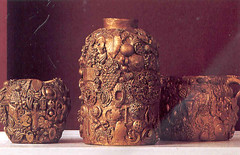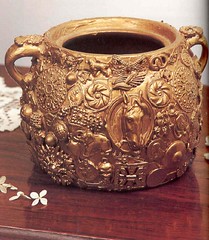Memory Jugs
I dabble in several forms of art and crafts rather than specialize in one.
I am always trying to learn new techniques, new styles, new mediums.
But what I am drawn to in all forms, is memory crafts.
I appreciate art that incorporates photographs, or trinkets, or clothing from a loved one.
When art celebrates the life of another, or one's past, or illustrates a recollection...that to me holds more meaning than something more esoteric.
My love of both memory crafts and folk art explains why I adore memory jugs.
Too, there's a whimsical quality that just makes me smile.

(click on image to enlarge)
From the book, By Hand: 25 Beautiful Objects to Make in the American Folk Art Tradition, 2001
Folk Art is defined as everyday household items that were decorated by common folk who were untrained in art.
Memory jugs were popular in Victorian times.
Some people believe the craft was not only a hobby for women, but originated from African mourning vessels--a ritual slaves brought with them to the United States. History here.
The jugs were ceramicware first covered in some sort of putty, then completely embedded in mementos--buttons, charms, trinkets, shards of china, seashells, pieces of jewelry, and all forms of personal paraphernalia.
These were memory-laden mosaics...three dimensional scrapbooks.

The jugs were not always painted one color like the examples I have pictured here.
This jug is "built on a molasses jug, it is covered with an extraordinary assemblage including old buttons, an onyx mourning cross, shells, marbles, keys, a belt buckle, broach, stones, English coins, bottles, ceramic people, metallic objects,screws, chains, jewelry, a wishbone, and more. It is topped with a glass finial. It has a pencil eraser holder with a date of 1886 on it. The three coins are all Victorian."
It is pictured on this antiques site.

In essence, these are time capsules.
"In a time when more and more of our everyday objects are mass produced, these very personal pieces hold great intrigue: they might have been intended as memorials or grave markers, or as a way of honoring family or friend, but whatever the purpose, these fascinating pieces link past to present as poignant narratives. Each of these vessels is encrusted with favorite bits that are too interesting to throw away but are too personal to reveal their meaning. What tale can be told by a vessel encrusted with a pipe, a toy deer, miniature china dishes, a glass doll, beads, walnuts, and upholstery tacks? Did it honor the memory of a dead relative, celebrate the living, or simply make use of attractive found objects? Could it be that making memory ware was a common handicraft of the day, with no sentiments attached?"
(source)
Today, of course, present day jugs are also considered a form of recycling.
But I like the more personal approach--to make a work of art that also creates a memory, a way to salvage bits of your childhood that would have been tossed aside.
I have a frame, for example, that I covered in trinkets from childhood.
I'll have to find it in storage and post it later.
But I always thought that would be a fun way to commemorate a year in the life of your child, and see how the trinkets changed every year.
You know, the McDonalds characters in the Happy Meals, the tokens from Chuck E Cheese, or the jewelry from Disneyland.
I think it's a craft worth knowing about and trying--worthwhile in so many ways.
I am always trying to learn new techniques, new styles, new mediums.
But what I am drawn to in all forms, is memory crafts.
I appreciate art that incorporates photographs, or trinkets, or clothing from a loved one.
When art celebrates the life of another, or one's past, or illustrates a recollection...that to me holds more meaning than something more esoteric.
My love of both memory crafts and folk art explains why I adore memory jugs.
Too, there's a whimsical quality that just makes me smile.

(click on image to enlarge)
From the book, By Hand: 25 Beautiful Objects to Make in the American Folk Art Tradition, 2001
Folk Art is defined as everyday household items that were decorated by common folk who were untrained in art.
Memory jugs were popular in Victorian times.
Some people believe the craft was not only a hobby for women, but originated from African mourning vessels--a ritual slaves brought with them to the United States. History here.
The jugs were ceramicware first covered in some sort of putty, then completely embedded in mementos--buttons, charms, trinkets, shards of china, seashells, pieces of jewelry, and all forms of personal paraphernalia.
These were memory-laden mosaics...three dimensional scrapbooks.

The jugs were not always painted one color like the examples I have pictured here.
This jug is "built on a molasses jug, it is covered with an extraordinary assemblage including old buttons, an onyx mourning cross, shells, marbles, keys, a belt buckle, broach, stones, English coins, bottles, ceramic people, metallic objects,screws, chains, jewelry, a wishbone, and more. It is topped with a glass finial. It has a pencil eraser holder with a date of 1886 on it. The three coins are all Victorian."
It is pictured on this antiques site.

In essence, these are time capsules.
"In a time when more and more of our everyday objects are mass produced, these very personal pieces hold great intrigue: they might have been intended as memorials or grave markers, or as a way of honoring family or friend, but whatever the purpose, these fascinating pieces link past to present as poignant narratives. Each of these vessels is encrusted with favorite bits that are too interesting to throw away but are too personal to reveal their meaning. What tale can be told by a vessel encrusted with a pipe, a toy deer, miniature china dishes, a glass doll, beads, walnuts, and upholstery tacks? Did it honor the memory of a dead relative, celebrate the living, or simply make use of attractive found objects? Could it be that making memory ware was a common handicraft of the day, with no sentiments attached?"
(source)
Today, of course, present day jugs are also considered a form of recycling.
But I like the more personal approach--to make a work of art that also creates a memory, a way to salvage bits of your childhood that would have been tossed aside.
I have a frame, for example, that I covered in trinkets from childhood.
I'll have to find it in storage and post it later.
But I always thought that would be a fun way to commemorate a year in the life of your child, and see how the trinkets changed every year.
You know, the McDonalds characters in the Happy Meals, the tokens from Chuck E Cheese, or the jewelry from Disneyland.
I think it's a craft worth knowing about and trying--worthwhile in so many ways.
Labels: history, Inspiration from books and mags, memory craft




13 Comments:
GREAT post! I have been intrigued w/ memory jars for a while and have a large stash of 'tidbits' awaiting my first attempt! PLEASE post your picture frame!!
This comment has been removed by a blog administrator.
Fascinating! I think I would use the unpainted version for memory stuff. The painted vessels look really nice, but it changes the objects too much for my taste. Thank you for introducing this to me and I am looking forward to see your picture frame, too.
These are lovely. I tried to make one a while back after seeing one at the Museum of Fine Arts. Mine was pretty awful, and I abandoned it before it was even half done.I was trying to glue them on and was going to grout them. I think the paint has a unifying effect. I recently found a small crock at the salvation army, It is covered with buttons embedded in some kind of putty, that must be the key.I'm looking forward to seeing yours.
what a great idea - a reason to have kept the "little stuff" that I just cannot throw out!
I like the concept of memory stuff. It makes the articles all the more special and brings back fond memories when you look at them. Folk Art is very interesting with the stories that it tells through art.
What a wonderful idea! The jugs are gorgeous. I especially like the unpainted one. I save all kinds of bottles. I'll have to try something like this--especially after the next time I go culling through the kids' rooms! ;-) Thanks for sharing.
I want to try and make one! What does the jug have to be made of, can it be glass? Also what do you use to adhere the items on with and what is in between the items. Would cement work, the kind you patch with that sets up really quick?
Thanks, Pap
So many people have asked me about this, I probably should comment here. Historically, putty was used on glass or pottery. But I mean, you can do whatever you like. Check out my June 2008 post about an artist who glued trinkets all over a doll. Basically this is almost a mosaic, just without the grout. I searched the web quickly for some ideas. I know there are two basic methods of mosaic, direct and indirect (meaning either to lay pieces into a cement, or glue then grout). This site suggests mastic.
Here's some kind of water putty
This says linseed
putty
Some other articles talk about putty made from lime. This one says joint compound
This one uses plaster of paris, but a comment says use thin set cement instead.
I've made lots of mosaics, but I always grout. I've made frames with really light items like jewelry, and I've used Aleene's Thick Designer Tacky glue, that dries clear. I put my pieces so tightly together, that no grout is needed on those anyway. I hope this was helpful,
Barb
Oops, I messed up on the linseed putty link. Correct link here.
I actually make this now and again and like to use tile adhesive as the medium, and then paint over or around the pieces.
Just wanted to drop you a note, say hello and offer a little information about the types of “Putty” you referred to. Water Putty is Durham’s Rock Hard, an old powered spackle-like substance used to fill walls and most types of wood. It is very durable and can be found in the paint departments at Lowe’s or Home Depot.
Linseed Putty is made from “Boiled” Linseed Oil and Whiting, a natural dry ground Calcium Carbonate, which used to be used as window putty. Also called Swedish Putty, you mix the two materials together and make a stiff past which slowly dries and sets to a solid. Art/Craft stores usually carry it.
Lime Putty, is usually wall plaster mixed with water and Type M Lime, to make the plaster sticky and stiffer while you apply it to lath or mixed with cement while making block/brick walls. Also available from Building Material Suppliers.
I would not use Plaster of Paris, as if you have a fast setting mix, it will crack. If you want to modernize your process, there are many other building products which would work very well.
All the best.
RedFlint
which of these putty's would work best on a glass jug? i want to use the one that would be least likely to crack over the years or come off the glass somehow..
thanks if someone can tell me which is best to use.
Post a Comment
<< Home